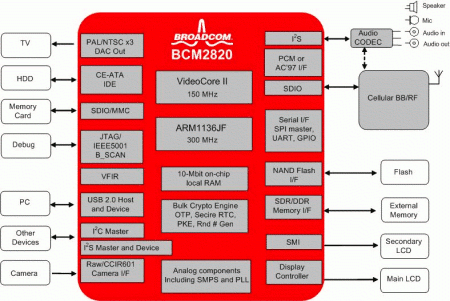Broadcom app processor targets Linux phones
Nov 9, 2006 — by LinuxDevices Staff — from the LinuxDevices Archive — 7 viewsOne of the world's largest fabless semiconductor vendors has entered the market for ARM-based application processors. Broadcom's BCM2820, now sampling, weds a 300MHz ARM11 core with a 150MHz “VideoCore” graphics processor. It targets high-volume consumer products, and “fully supports Linux today,” Broadcom says.
Broadcom is best known for MIPS-based networks processors, graphics coprocessors for set-top boxes, and other peripheral chips. However, the BCM2820 targets mobile phones, mobile TVs, portable audio/video/game devices, and other high-volume products requiring high integration and multimedia performance, along with low power consumption, the company says.
The BCM2820 combines Broadcom's “VideoCore” graphics processor with an ARM11 core that can be clocked up to 300MHz. The design also includes a full complement of consumer electronics I/O, including a CE-ATA interface for tiny hard drives and a camera interface said to support imagers up to 8 megapixels.

Broadcom's BCM2820 architecture diagram
(Click to enlarge)
Broadcom's VideoCore graphics processor is described as “fully programmable,” with the goal of enabling support for emerging video codecs without a change of hardware. The powerful graphics processor enables ARM11 clock speeds as low as 10MHz, during H.264 video decoding, the company claims.
Broadcom previously shipped several generations of VideoCore graphics processors, in its BCM27xx-series graphics co-processors for mobile phones. All BCM27xx-series devices are software-compatible with the BCM2820, according to the company.
Additional touted features include:
- Encode, or decode and display MPEG-4/H.264 VGA video at 30 frames per second
- NTSC/PAL TV output via composite, component, or S-video connections
- Supports a variety of cellular basebands, including 3G EDGE, WEDGE, and HEDGE
- Supports 802.11x and Bluetooth radio chipsets
Broadcom claims that the BCM2820 can handle “most software applications and operating systems” currently available for mainstream mobile wireless devices. The company offers a variety of Linux-based software and middleware for the chip, including:
- Wireless LAN and Bluetooth stacks
- Audio and video CODECs
- MPEG4
- H.264
- Windows Media
- MP3
- 3D audio and audio visualizations
- Slideshow transitions
- Image editing applications
- 3D graphics acceleration
- Video camcorder applications with visual effects
- WMDRM
- MTP
- PlaysForSure
- Drivers to support cellular baseband modems
Mark Casey, Broadcom's general manager of mobile multimedia, stated, “By extending our VideoCore technology into the applications processor market, we're simplifying the development of next generation mobile wireless devices, while saving space and power, and optimizing performance.”
According to ABA principal analyst Alan Varghese, “The market for mobile applications processors will exceed $5.5 Billion dollars in 2007. Broadcom's product portfolio of industry leading video processor engines, integration track record with other mobile technologies, and emphasis on software can make it a strong player in this market.”
Broadcom reported revenues of $2.67 billion in 2005. Its CFO resigned in late September, amidst an ongoing SEC investigation into possible mis-reporting of stock option grants.
Availability
The BCM2820 is now sampling to early access customers, along with a development kit that includes a Linux BSP, a suite of multimedia codecs, and application software. The chip is priced at $15 in quantities of 10,000.
This article was originally published on LinuxDevices.com and has been donated to the open source community by QuinStreet Inc. Please visit LinuxToday.com for up-to-date news and articles about Linux and open source.